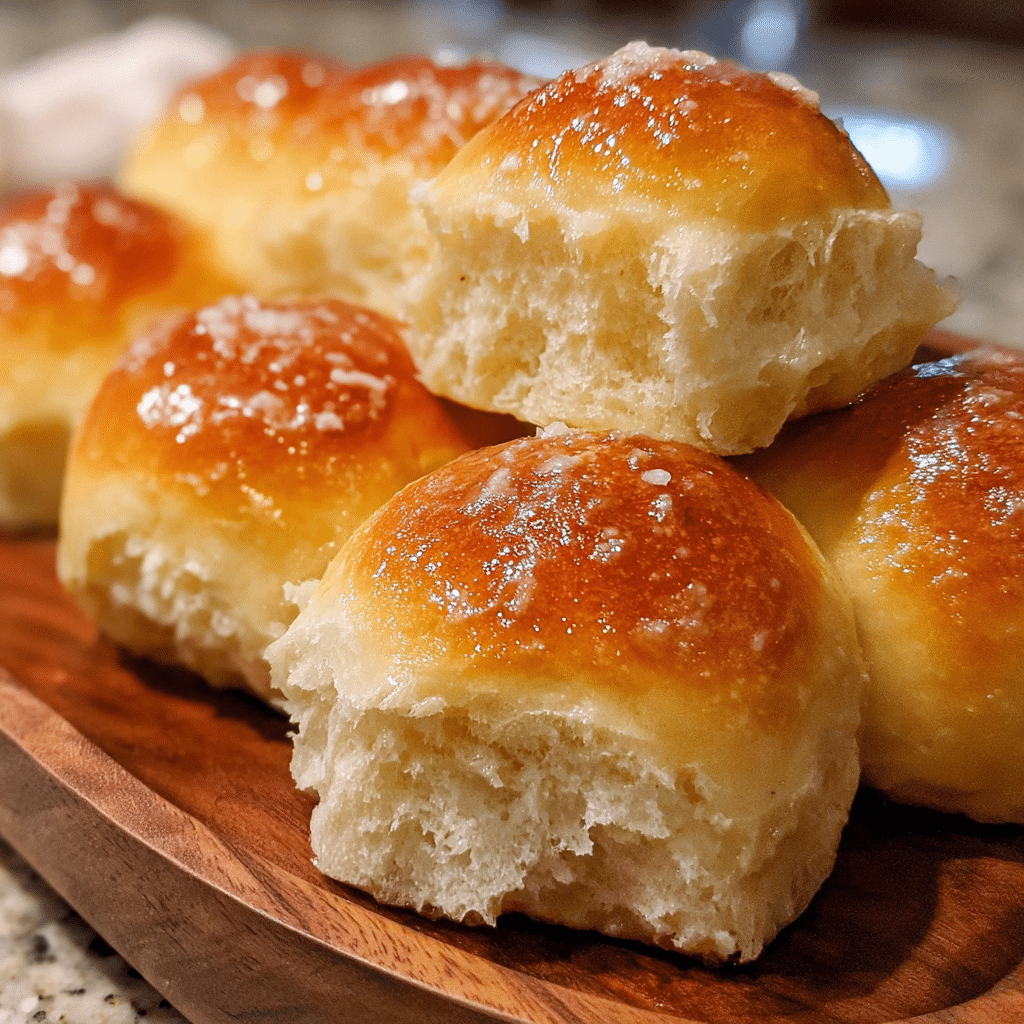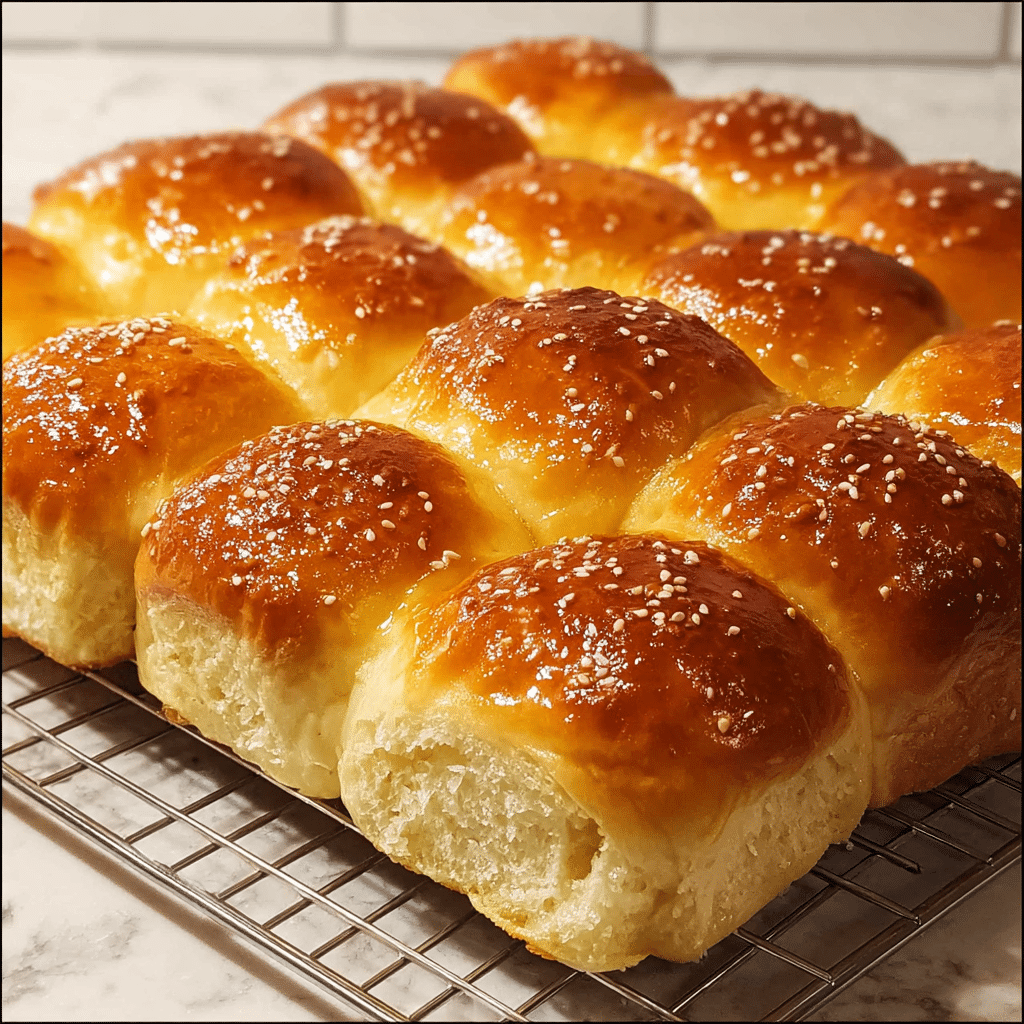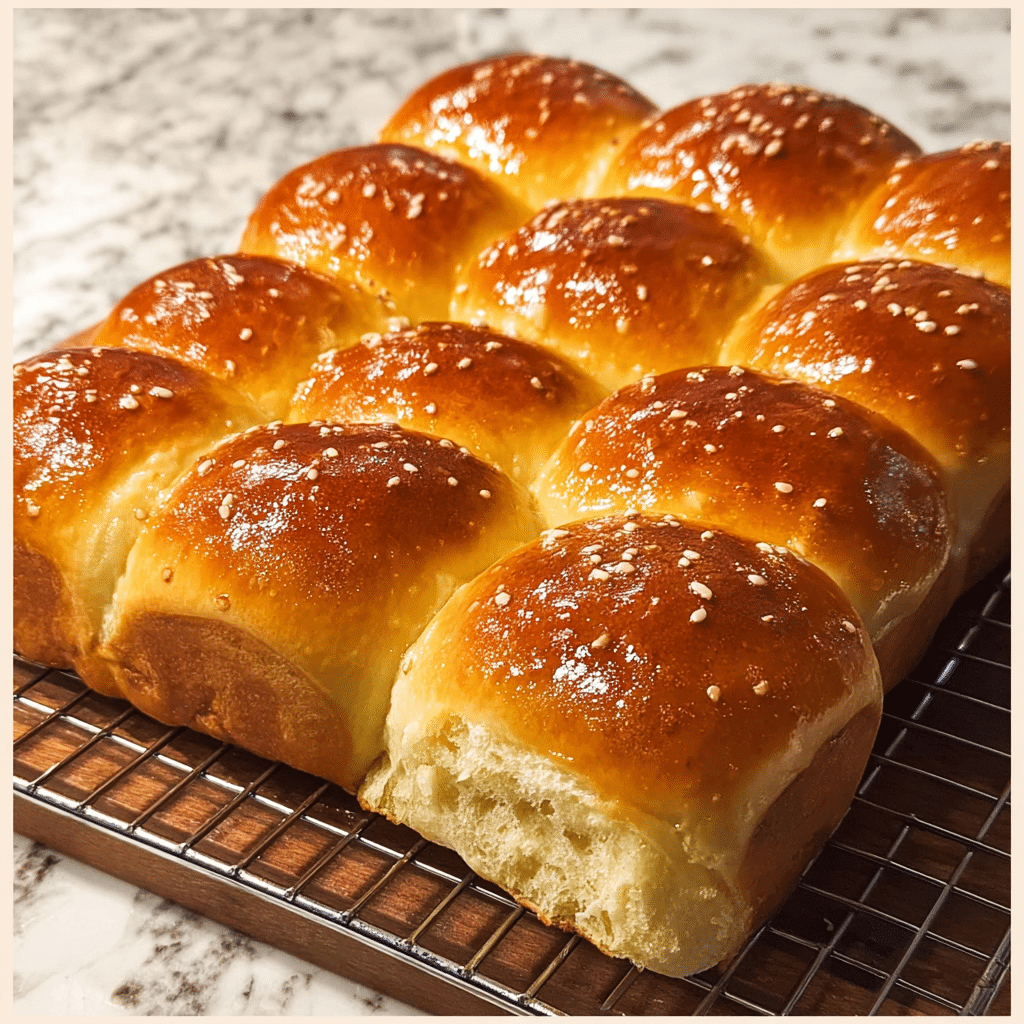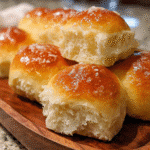Buttery dinner rolls are the crown jewel of any dinner table, yet so many home bakers struggle with dense, heavy rolls that lack that perfect pillowy texture. Are you tired of dinner rolls that turn out tough and disappointing instead of the soft, fluffy masterpieces you envision?
Hi there! I’m Lisa, the heart and soul behind Recipesrealm, and I’ve spent countless evenings perfecting this buttery dinner rolls recipe that will transform your dining experience forever. After years of testing different techniques and ingredients, I’ve discovered the secret to creating rolls so soft and buttery that they practically melt in your mouth. This recipe delivers bakery-quality results every single time, whether you’re preparing for a holiday feast or a cozy family dinner.
As someone who’s been passionate about baking for over a decade, I understand the frustration of following recipes that promise perfection but deliver mediocre results. That’s why I’ve meticulously crafted this foolproof method that takes the guesswork out of bread baking. In this comprehensive guide, I’ll share my proven techniques for ingredient selection, proper kneading methods, rising tips, and the finishing touches that make these rolls absolutely irresistible.
Why This Buttery Dinner Rolls Recipe Works
This buttery dinner rolls recipe succeeds where others fail because it focuses on three critical elements: superior flavor development, incredible convenience, and remarkable versatility that adapts to any occasion.
• Uses premium ingredients that are easily accessible – Quality butter, bread flour, and fresh yeast create the foundation for exceptional flavor without requiring specialty shopping trips
• Achieves perfect texture through precise hydration ratios – The carefully balanced liquid-to-flour ratio ensures consistently soft, tender rolls every time
• Delivers restaurant-quality results in your home kitchen – Professional techniques simplified for home bakers guarantee bakery-worthy rolls without expensive equipment
• Perfect for both weeknight dinners and special celebrations – This versatile recipe scales beautifully whether you’re feeding four or forty guests
• Creates make-ahead convenience with freezer-friendly options – Prepare rolls in advance and have fresh-baked bread ready whenever you need it
Choosing the Right Ingredients for Buttery Dinner Rolls
Selecting premium ingredients forms the foundation of exceptional buttery dinner rolls, and understanding why each component matters will elevate your baking dramatically.
Essential Flour Selection for Perfect Buttery Dinner Rolls
Bread Flour vs All-Purpose: Bread flour contains higher protein content (12-14%) compared to all-purpose flour (10-12%), creating stronger gluten development that produces the ideal chewy yet tender texture in buttery dinner rolls.
Quality Indicators: Look for unbleached bread flour with a slightly cream-colored appearance rather than stark white, indicating minimal processing and superior flavor development.
Storage Tips: Store flour in airtight containers in cool, dry locations to maintain freshness and prevent rancidity that can affect your buttery dinner rolls’ taste.
Premium Butter Selection for Maximum Flavor
European-Style Butter: Choose high-fat content butter (82-85% fat) for richer flavor and superior texture in your buttery dinner rolls.
Temperature Considerations: Room temperature butter incorporates more easily into dough, while cold butter can be grated for different texture effects.
Substitution Options: While unsalted butter provides the best control over salt levels, salted butter can work if you reduce added salt by half.

Ingredients & Prep for Perfect Buttery Dinner Rolls
Creating exceptional buttery dinner rolls requires careful attention to ingredient preparation and proper timing for optimal results.
Essential Ingredients for Buttery Dinner Rolls
Dry Ingredients:
- 4 cups bread flour (plus extra for dusting)
- 2 tablespoons granulated sugar
- 2 teaspoons salt
- 1 packet (2¼ teaspoons) active dry yeast
Wet Ingredients:
- 1 cup warm milk (110°F)
- ⅓ cup unsalted butter, melted
- 1 large egg, room temperature
For Finishing:
- 3 tablespoons butter, melted
- Flaky sea salt for sprinkling
Prep Work Essentials for Buttery Dinner Rolls
Yeast Activation: Combine warm milk with a pinch of sugar, then sprinkle yeast over the surface. Allow 5-10 minutes until foamy, confirming yeast viability for your buttery dinner rolls.
Temperature Control: Ensure all ingredients reach room temperature except the milk, which should be warm to touch but not hot enough to kill the yeast.
Equipment Preparation: Grease mixing bowls, baking pans, and measuring tools with butter to prevent sticking and add extra richness to your buttery dinner rolls.
Pantry Staples That Enhance Buttery Dinner Rolls
Flavor Enhancers:
- Honey or maple syrup for subtle sweetness
- Vanilla extract for aromatic depth
- Fresh herbs like rosemary or thyme for savory variations
Texture Improvers:
- Vital wheat gluten for extra chewiness
- Potato flour for moisture retention
- Milk powder for enhanced browning
Step-by-Step Cooking Instructions for Buttery Dinner Rolls
Follow these detailed instructions to achieve bakery-quality buttery dinner rolls with consistent, professional results every time.
Pre-Cooking Prep for Buttery Dinner Rolls
Step 1: Activate yeast by combining warm milk (110°F) with 1 teaspoon sugar in a large mixing bowl. Sprinkle yeast over the surface and let stand 5-10 minutes until foamy, indicating active yeast ready for your buttery dinner rolls.
Step 2: In a separate bowl, whisk together bread flour, remaining sugar, and salt, creating a well in the center for easy incorporation of wet ingredients.
Step 3: Beat the egg lightly and combine with melted butter, ensuring the butter isn’t hot enough to cook the egg when making buttery dinner rolls.
Mixing and Kneading Method for Buttery Dinner Rolls
Step 4: Pour the yeast mixture into the flour well, followed by the egg-butter mixture. Using a wooden spoon, stir until a shaggy dough forms and no dry flour remains visible.
Step 5: Turn dough onto a lightly floured surface and knead vigorously for 8-10 minutes until smooth, elastic, and slightly tacky but not sticky. Proper kneading develops gluten structure essential for light, airy buttery dinner rolls.
Step 6: Perform the windowpane test by stretching a small portion of dough thin enough to see light through it without tearing, confirming adequate gluten development.
First Rise Process for Buttery Dinner Rolls
Step 7: Place kneaded dough in a buttered bowl, turning to coat all surfaces. Cover with a damp towel or plastic wrap, creating a warm, humid environment for optimal rising.
Step 8: Allow dough to rise in a warm location (75-80°F) for 1-1.5 hours until doubled in size. The dough should spring back slowly when gently poked, indicating readiness for shaping your buttery dinner rolls.
Shaping Technique for Buttery Dinner Rolls
Step 9: Gently deflate risen dough and turn onto a lightly floured surface. Divide into 12 equal portions using a kitchen scale for uniform buttery dinner rolls (approximately 2.5 ounces each).
Step 10: Shape each portion into smooth balls by rolling against the work surface with cupped hands, creating surface tension that helps rolls maintain their shape during baking.
Step 11: Arrange shaped rolls in a buttered 9×13-inch baking dish, spacing them about 1 inch apart to allow for expansion during the final rise.
Final Rise and Baking for Buttery Dinner Rolls
Step 12: Cover shaped rolls with a clean towel and let rise 45-60 minutes until puffy and touching each other lightly, creating the characteristic pull-apart texture of perfect buttery dinner rolls.
Step 13: Preheat oven to 375°F during the last 15 minutes of rising time, ensuring proper temperature for optimal oven spring.
Step 14: Brush risen rolls gently with melted butter and sprinkle with flaky sea salt if desired. Bake 18-22 minutes until golden brown on top and internal temperature reaches 190°F.
Step 15: Remove from oven and immediately brush with remaining melted butter for glossy, flavorful tops that make these buttery dinner rolls irresistible.
Pro Tips for Perfect Buttery Dinner Rolls
Master these professional techniques to ensure your buttery dinner rolls turn out perfectly every single time, regardless of your baking experience level.
Avoiding Common Mistakes with Buttery Dinner Rolls
Preventing Dense Texture: Never add too much flour during kneading, as this creates heavy, dense rolls. The dough should remain slightly tacky but not sticky when properly developed.
Temperature Control: Use a thermometer to verify milk temperature and avoid killing yeast with excessive heat, which ruins the rising capability essential for light buttery dinner rolls.
Proper Rising Environment: Create consistent warmth by placing dough near (not on) a preheating oven or in a slightly warm oven with the light on, ensuring optimal conditions for yeast activity.
Essential Tool Recommendations for Buttery Dinner Rolls
Digital Kitchen Scale: Measure ingredients by weight for consistent results, especially important for flour which can vary significantly when measured by volume.
Instant-Read Thermometer: Monitor milk temperature for yeast activation and internal bread temperature for perfect doneness in your buttery dinner rolls.
Stand Mixer with Dough Hook: While hand kneading works perfectly, a stand mixer reduces effort and ensures consistent gluten development for professional-quality results.
Storage and Reheating Tips for Buttery Dinner Rolls
Short-Term Storage: Keep baked rolls fresh for 2-3 days at room temperature in airtight containers or wrapped in plastic wrap to maintain their soft texture.
Freezer Storage: Freeze fully baked and cooled rolls for up to 3 months in freezer bags, maintaining quality for future meals without compromise.
Reheating Method: Wrap frozen rolls in damp paper towels and microwave 30-45 seconds, or warm in a 350°F oven for 5-7 minutes to restore fresh-baked texture and warmth.

Flavor Variations for Buttery Dinner Rolls
Transform your basic buttery dinner rolls into exciting variations that complement different meals and satisfy diverse taste preferences.
Herb-Infused Buttery Dinner Rolls
Fresh Herb Blend: Incorporate 2 tablespoons chopped fresh rosemary, thyme, and sage into the dough for aromatic, savory rolls perfect with roasted meats.
Garlic Butter Finish: Mix minced garlic with melted butter for brushing, creating restaurant-style garlic rolls that elevate any dinner.
Everything Seasoning: Top rolls before baking with everything bagel seasoning for a trendy twist on classic buttery dinner rolls.
Sweet Variations of Buttery Dinner Rolls
Cinnamon Sugar: Roll shaped dough in cinnamon sugar before final rising, creating sweet rolls perfect for breakfast or dessert.
Honey Oat: Replace 1 cup flour with rolled oats and add 2 tablespoons honey for nutty, naturally sweet buttery dinner rolls.
Orange Zest: Add fresh orange zest to the dough and brush with honey-orange glaze for bright, citrusy flavors.
Global-Inspired Buttery Dinner Rolls
| Variation | Key Ingredients | Flavor Profile | Best Served With |
|---|---|---|---|
| Mediterranean | Sun-dried tomatoes, olives, oregano | Savory, herbaceous | Pasta dishes, grilled fish |
| Asian-Inspired | Sesame seeds, scallions, soy sauce | Umami, nutty | Stir-fries, Asian soups |
| Mexican-Style | Jalapeños, cheddar, cumin | Spicy, cheesy | Barbecue, Mexican cuisine |
| Indian-Spiced | Nigella seeds, turmeric, cardamom | Aromatic, exotic | Curries, Indian dishes |
Serving Suggestions for Buttery Dinner Rolls
Elevate your dining experience by pairing these versatile buttery dinner rolls with complementary dishes and beverages that enhance their rich, comforting flavors.
Perfect Meal Pairings with Buttery Dinner Rolls
Holiday Feasts: These buttery dinner rolls shine alongside traditional holiday dishes like roasted turkey, glazed ham, and creamy casseroles, absorbing delicious gravies and sauces.
Comfort Food Dinners: Pair with hearty stews, pot roasts, and braised meats where the soft texture of buttery dinner rolls provides the perfect vehicle for sopping up flavorful broths.
Elegant Dinner Parties: Serve with sophisticated dishes like herb-crusted lamb, grilled salmon, or beef tenderloin, where the refined simplicity of buttery dinner rolls complements without competing.
Beverage Pairings for Buttery Dinner Rolls
Non-Alcoholic Options: Fresh apple cider, sparkling grape juice, or herbal teas complement the rich butter flavors without overwhelming the palate.
Coffee Pairings: Light to medium roast coffees pair beautifully with the subtle sweetness and buttery richness of these dinner rolls.
Tea Selections: Earl Grey or chamomile teas provide aromatic complexity that enhances the comforting qualities of fresh-baked buttery dinner rolls.

FAQs About Buttery Dinner Rolls
Can I make butter dinner rolls ahead of time?
Absolutely! You can prepare the dough through the first rise, then refrigerate overnight. Shape the rolls the next day and allow extra rising time as cold dough takes longer to proof. Alternatively, freeze shaped unbaked rolls and thaw/rise them when needed.
What causes buttery dinner rolls to turn out dense?
Dense rolls typically result from too much flour, dead yeast, insufficient kneading, or inadequate rising time. Always measure flour properly, test yeast freshness, knead until smooth and elastic, and allow proper rising time for light, fluffy results.
How do I know when my buttery dinner rolls are fully baked?
Use an instant-read thermometer to check internal temperature, which should reach 190°F. Alternatively, tap the bottom of a roll – it should sound hollow when fully baked. The tops should be golden brown and spring back when lightly touched.
Can I use different types of flour for buttery dinner rolls?
While bread flour produces the best results due to higher protein content, all-purpose flour works acceptably. Avoid cake flour or pastry flour as they lack sufficient protein for proper structure. Whole wheat flour can replace up to 50% of bread flour for heartier rolls.
Why didn’t my buttery dinner rolls rise properly?
Poor rising usually stems from inactive yeast, incorrect temperatures, or environmental factors. Ensure yeast is fresh and properly activated, maintain warm (not hot) rising conditions, and protect dough from drafts that can inhibit yeast activity.
How long do homemade buttery dinner rolls stay fresh?
Properly stored butter dinner rolls remain fresh for 2-3 days at room temperature in airtight containers. For longer storage, freeze baked rolls for up to 3 months, then thaw and warm before serving to restore their soft texture.
Can I make smaller or larger buttery dinner rolls?
Certainly! Divide dough into more pieces for slider-sized rolls or fewer pieces for larger rolls, adjusting baking time accordingly. Smaller rolls bake faster (12-15 minutes) while larger rolls need additional time (25-30 minutes).
What’s the best way to reheat leftover buttery dinner rolls?
Wrap rolls in damp paper towels and microwave for 20-30 seconds, or place in a 350°F oven for 5-7 minutes. For frozen rolls, thaw first or add extra warming time to restore the soft, fresh-baked texture.
Conclusion
Creating perfect buttery dinner rolls doesn’t have to be complicated or intimidating when you follow this proven recipe and technique guide. These soft, fluffy, golden rolls will become your go-to recipe for every occasion, from casual family dinners to special holiday celebrations. The combination of premium ingredients, proper technique, and careful attention to timing ensures bakery-quality results every single time.
Remember that baking is both an art and a science – while precise measurements matter, don’t be afraid to adjust based on your environment and preferences. With practice, you’ll develop an intuitive feel for the dough and timing that will make you confident in creating these spectacular buttery dinner roll whenever the craving strikes.
Fire up your oven and try this recipe tonight! Your family and friends will be amazed by these restaurant-quality rolls emerging from your home kitchen. Join thousands of home bakers who’ve discovered the joy and satisfaction of creating these perfect butter dinner rolls from scratch.
Try our complementary recipes like Easy Sweet Potato Casserole with Marshmallows or Quick Fall Breakfast: Pumpkin French Toast to create complete, memorable meals centered around these incredible rolls. The possibilities are endless when you master this fundamental bread-baking technique!
If you loved this recipe, don’t forget to share it with your friends or save it to try later! I’d be thrilled to see your personal touch—share your photos on Pinterest
Print
Soft Fluffy Buttery Dinner Rolls Recipe
- Total Time: 1 hour 45 minutes
- Yield: 12 rolls 1x
- Diet: Vegetarian
Description
Soft, fluffy, and buttery dinner rolls that are perfect for family meals, holidays, or any dinner table. Light on the inside with a golden, tender crust.
Ingredients
4 cups all-purpose flour
1/4 cup sugar
2 1/4 tsp active dry yeast (1 packet)
1 tsp salt
1 cup warm milk (110°F/43°C)
1/4 cup unsalted butter, melted
1 large egg
2 tbsp unsalted butter, melted (for brushing)
Instructions
1. In a large bowl, combine warm milk, sugar, and yeast. Let sit for 5–10 minutes until foamy.
2. Add melted butter, egg, flour, and salt. Mix until a soft dough forms.
3. Knead the dough on a floured surface for 6–8 minutes until smooth and elastic.
4. Place dough in a greased bowl, cover, and let rise for 1–1.5 hours until doubled in size.
5. Punch down the dough and divide into 12 equal pieces. Shape into balls and place on a greased baking sheet or pan.
6. Cover and let rise for another 30–40 minutes.
7. Preheat oven to 375°F (190°C). Bake rolls for 15–20 minutes until golden brown.
8. Brush warm rolls with melted butter before serving.
Notes
For extra softness, brush the tops with butter while still warm.
You can add herbs or garlic for flavored rolls.
Store leftovers in an airtight container to maintain freshness.
- Prep Time: 20 minutes
- Cook Time: 15–20 minutes
- Category: Bread, Side Dish
- Method: Baked
- Cuisine: American
Nutrition
- Serving Size: 1 roll
- Calories: 150
- Sugar: 3g
- Sodium: 180mg
- Fat: 6g
- Saturated Fat: 3.5g
- Unsaturated Fat: 2g
- Trans Fat: 0g
- Carbohydrates: 21g
- Fiber: 1g
- Protein: 4g
- Cholesterol: 30mg
Keywords: Dinner Rolls, Soft Rolls, Buttery Rolls, Homemade Bread

